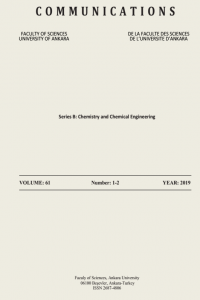The Rest Potentials of Platinum, Rhodium and Iridium Electrodes
The Rest Potentials of Platinum, Rhodium and Iridium Electrodes
The reduced and oxidized platinum, rhodium and iridium electrodes were alterna- tely dipped, as, cathode into the Solutions of 1 N H2SO4, 1 N HNO3, 1 N H2SO4 + 1/8 M K2Cr2O7, 1 N HNO3 +1 /8 M K2Cr2O7, 1 /4 M CrO3, 1 N H2SO4 + 10”2 M Ce (IV) SO4, İN NaOII, 1 N NaOH + 1 /8 M K2 Cr2 O7. The potentials with respect to time were mea- sured against a calomel electrode, (rest potentials). The electrodes were pretreated in two separate ways. The electrode, as anode, was dipped into a 1 N solution of H2SO4. A current of 200 mA was passed for a period of five minutes.Then the oxidized electrode was again dipped into a saıne type solution with continuous flow of nitrogen while being connected to a calomel electrode in short circuit (reduced electrode). The electrodes prepared according to the above procedure were again oxidized, anodically, for fifteen minutes under a current of 200 mA (oxidized electrodes). Using the same electrolyte, the rest potentials for platinum, rhodium and iridium were found to have different values. The rest potentials for -these metals in the Solutions mentioned above were very close to the cquilibrium potentials of the same metals in the oxidized state this indicates. That they were being oxidized in these Solutions.The time required for such metals to reach equilibrium was shortest for iridium next for rhodium and platinum.
Keywords:
Rest Potentials, Platinum Rhodium,
___
- Communications Faculty of Sciences University of Ankara Series B Chemistry and Chemical Engineering
- ISSN: 1303-6017
- Başlangıç: 1948
- Yayıncı: Ankara Üniversitesi
